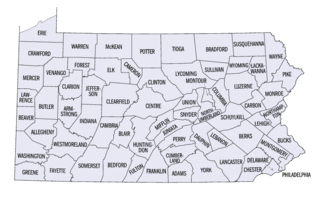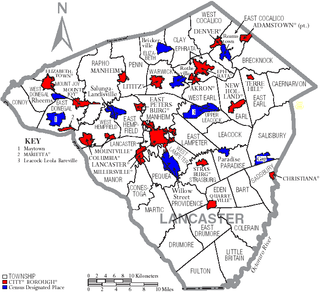| Wrightsville dam | |
|---|---|
| Official name | Wrightsville Dam |
| Location | Lancaster / York counties, Pennsylvania, USA |
| Construction began | 1840 |
| Opening date | 1840 |
| Operator(s) | defunct |
| Dam and spillways | |
| Impounds | Susquehanna River |
| Height | 10 feet |
| Length | ~5,000 feet |
The Wrightsville Dam was a 19th-century dam on the lower Susquehanna River between Wrightsville and Columbia, Pennsylvania.

The Susquehanna River is a major river located in the northeastern and mid-Atlantic United States. At 464 miles (747 km) long, it is the longest river on the East Coast of the United States that drains into the Atlantic Ocean. With its watershed, it is the 16th-largest river in the United States, and the longest river in the early 21st-century continental United States without commercial boat traffic.

Wrightsville is a borough in York County, Pennsylvania, United States. The population was 2,320 at the 2010 census. Wrightsville borough has a police department, historic society, and a volunteer fire company.

Columbia, formerly Wright's Ferry, is a borough (town) in Lancaster County, Pennsylvania, 28 miles (45 km) southeast of Harrisburg on the east (left) bank of the Susquehanna River, across from Wrightsville and York County and just south of U.S. Route 30. The settlement was founded in 1726 by Colonial English Quakers from Chester County led by entrepreneur and evangelist John Wright. Establishment of the eponymous Wright's Ferry, the first commercial Susquehanna crossing in the region, inflamed territorial conflict with neighboring Maryland but brought growth and prosperity to the small town, which was just a few votes shy of becoming the new United States' capital. Though besieged for a short while by Civil War destruction, Columbia remained a lively center of transport and industry throughout the 19th century, once serving as a terminus of the Pennsylvania Canal. Later, however, the Great Depression and 20th-century changes in economy and technology sent the borough into decline. It is notable today as the site of one of the world's few museums devoted entirely to horology.
The low-head dam was constructed in 1840 to impound the waters of the Susquehanna to provide a slackwater pool to allow the safe passage of canal boats from the Pennsylvania Canal on the Columbia (Lancaster County) side across the mile-wide rocky river to the Susquehanna and Tidewater Canal on the Wrightsville (York County) side. [1]

Pennsylvania Canal(or sometimes Pennsylvania Canal system) refers generally to a complex system of transportation infrastructure improvements including canals, dams, locks, tow paths, aqueducts, and viaducts. The Canal and Works were constructed and assembled over several decades beginning in 1824, the year of the first enabling act and budget items. It should be understood the first use of any railway in North America was the year 1826, so the newspapers and the Pennsylvania Assembly of 1824 applied the term then to the proposed Right of ways mainly for the canals of the Main Line of Public Works to be built across the southern part of Pennsylvania.

Lancaster County, sometimes nicknamed the Garden Spot of America or Pennsylvania Dutch Country, is a county located in the south central part of the Commonwealth of Pennsylvania. As of the 2010 census, the population was 519,445. Its county seat is Lancaster.

The Susquehanna and Tidewater Canal between Wrightsville, Pennsylvania, and Havre de Grace, Maryland, at the head of Chesapeake Bay, provided an interstate shipping alternative to 19th-century arks, rafts, and boats plying the difficult waters of the lower Susquehanna River. Built between 1836 and 1840, it ran 43 miles (69 km) along the west bank of the river and rendered obsolete an older, shorter canal along the east bank. Of its total length, 30 miles (48 km) were in Pennsylvania and 13 miles (21 km) in Maryland. Though rivalry between Philadelphia, Pennsylvania, and Baltimore, Maryland, delayed its construction, the finished canal brought increased shipments of coal and other raw materials to both cities from Pennsylvania's interior. Competition from railroads was a large factor in the canal's decline after 1855. Canal remnants, including a lock keeper's house, have been preserved in Maryland, and locks 12 and 15 have been preserved in Pennsylvania. A copy of a detailed survey blueprint of the entire canal system including structures and property ownership details was donated by the Safe Harbor Water Power Corporation to Millersville University. The survey consists of 67 pages, 98 x 30 cm. and is undated but the assumption is the original was created while the canal was in use.







